Tree Stump Removal Cost
Last updated 12th September, 2025
What does it cost to remove a tree stump?
This guide contains all you need to know about tree stump removal, from the cost (which on average can be anywhere between £150 - £350) to expected timescales, methods available (stump grinding, tree root removal etc.) and how to remove tree stumps yourself.
Let's get started!
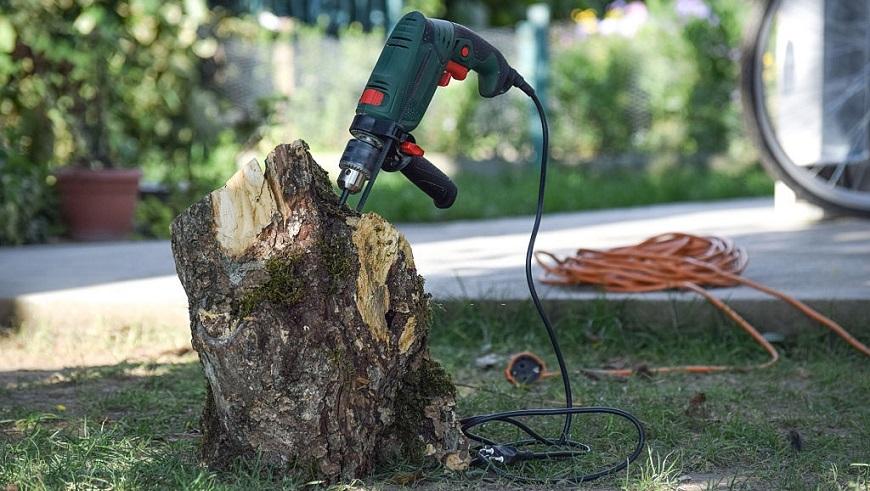
How Much is Tree Stump Removal?
The cost of removing a tree stump will involve multiple factors, most notably the size of the stump, the number of stumps you need removing and the method of extraction. It's also important to note within London and the surrounding areas labour and tree stump removal costs are more expensive than the rest of the UK.
Assuming that you require a single stump to be removed at an average size of five inches or smaller, the preferred removal method is often to dig up the stump and root network at around £150-£350 a day for labour costs – although some professionals may charge for the job and not their time, so it’s always best to get a quote with multiple companies.
What about multiple tree stumps?
If you require a larger stump, or several stumps, to be removed you may find that grinding them down with specialist machinery is a better option. Alternatively, you may choose to remove them through burning or using chemical methods, although though this is a much slower process and can take a while before you see any results.
Table of Contents
- How much is tree stump removal?
- Labour cost to remove tree stump
- What does removing a tree stump involve?
- What does grinding a tree stump involve?
- Other methods of stump removal
- Reasons to remove a tree stump
- DIY tree stump removal
- Cost to remove a tree
- Cleaning up after removing a tree stump
- The correct way to measure a tree stump
- Factors that impact tree stump removal costs
- How to save money when removing a tree stump
- Planting a tree
- Choosing the right professional
- FAQs
Tree Stump Removal and Stump Grinding Prices
The cost to remove a tree stump, along with the time it takes, can vary greatly depending on its size and the method used. The prices provided below should be taken as an average estimate, although the majority of removal services will advise they will need to see the stump first, prior to making an accurate quote.
| Size of Space | Removal Method | Cost |
|---|---|---|
| Single, smaller than 5 inches | Removal | £150-£200 |
| Single, larger than 5 inches, or multiple stumps | Removal | £200-£350 |
| Single, smaller than 5 inches | Grinding | £40-£80 |
| Single, larger than 5 inches, or multiple stumps | Grinding | £80-£350 |
If you have multiple stumps that require removal the price will increase incrementally, though many of the tradespeople contacted offered a discount when removing multiple stumps.
Stump Removal Cost Breakdown Calculator
Individual cost for removal of single small (5” or less) stump removal – Total Cost: £200
Labour
£120
Materials
£40
Waste Removal
£40
Labour Cost to Remove Tree Stump
On average labour will cost between £50-£150. Your tradesperson may charge per item, or give a cost for the job as a whole, it’s best to discuss with them and shop around before committing to the first quote given.
Depending on the method of removal used, as well as how deep the tree stump goes and the type of wood, removing a trees stump can take anything between 30 minutes to 4 hours. Again, because there are so many variables it’s best to ask your tradesperson for an estimate before they begin work.
What Does Removing a Tree Stump Involve?
Removing a tree stump refers to the physical excavation of the stump and usually the attached roots as well. This is often done by a professional, although you can bring the cost of removing a tree stump down by doing it yourself. However, it’s important to remember whilst you may save money taking on the job yourself, it can be physically demanding and could take longer than you expect.
The first step is to remove the dirt or surrounding surface from the stump by digging around its circumference, exposing as much of the base as possible to allow as much access to the root systems with tools as possible.
Once sufficient roots are showing you can begin cutting them, it’s best to do this with either garden loppers or a root saw. It is not recommended to use a chainsaw as they are not designed to come in contact with soil which can blunt or even damage them.
The next step is to pull the remaining roots from the ground by leveraging the trunk and using a grubbing hoe if available to loosen remaining roots from the ground. Once the majority of the roots have been removed you should be able to dislodge the stump from the ground and then proceed to fill in the hole once it has been removed.
What Does Grinding a Tree Stump Involve?
Stump grinding is a process of eliminating a tree stump using a specially designed machine, similar to a wood chipper. The machine is positioned over the stump and once operational, it will begin to grind down the wood beneath it and into the roots below.
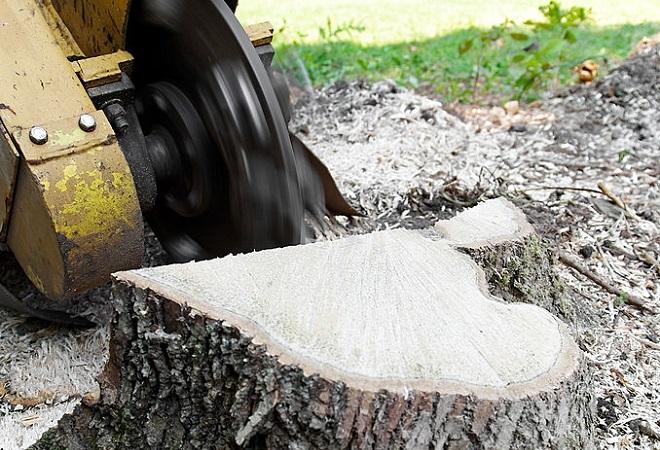
The depth that you grind to is usually dependant on the intended purpose of the area once the job is finished. If you are planning on using the space as a flower bed or lawn, you will need to grind deeper than if the stump is located in the perimeter or is going to be paved over. Once the grinding is complete you can fill the hole.
Other Methods of Stump Removal
Whilst stump removal and stump grinding are popular methods of elimination, they are not the only methods available. Burning a tree stump and chemical extraction are both valid options to get the job done; the method you choose will likely be influenced by cost effectiveness, time and whether you plan to complete the task yourself or hire a professional.
Burning
If done correctly burning tree stumps is a viable option of removal as it is cheap and reliable, but it’s important to consider the pros and cons of the method as well as the necessary safety precautions that need to be taken to do so, and consider if there are any legal restrictions you may face, such as ensuring the burning is carried out without causing nuisance to your neighbours through excessive smoke.
Depending on the size of the stump it may be considerably slower than physically removing it, and considerably longer than grinding it down.
How to Burn a Tree Stump
Before burning the stump ensure that other flammable materials are cleared away from the area including fallen leaves and any sticks or wooden materials to reduce the risk of fire spreading.
In order to effectively burn out a stump you must ensure there is sufficient air circulation so that the fire doesn’t smother. In order to do this, the stump may need several holes drilled into the top and sides, at a rough depth of up to 10 inches (but no less than 3 inches), to adequately penetrate the stump. This will enable the fire to hold and not be easily blown out.
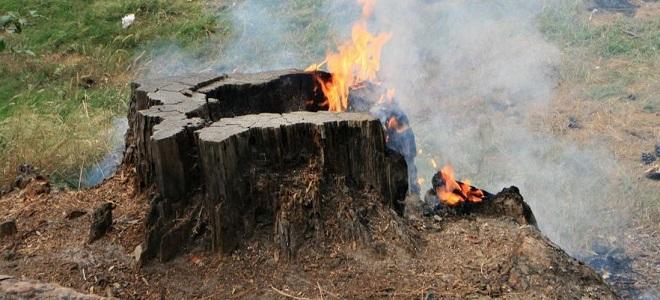
You may wish to use an accelerant to help the process such as charcoal or potassium nitrate within the holes, filling them half way, and then dissolve with hot water using a spouted cup or funnel. Use dry sticks or tinder to construct a tepee around the stump; these should be easy to light and will aid in keeping the fire alive. Once you are ready you can ignite the outer-layer of wood.
Keep in mind that depending on the size of the stump you may need to add more kindling to the area to keep the fire going and it may take some time for the stump itself to start burning. You will need to keep an eye on its progress; once the stump has been reduced to ash you can extinguish any remaining flames and dispose of the waste.
Do not leave the fire unattended; fires can quickly get out of hand so make sure you have adequate precautions in place should you need to extinguish it, or alternatively, hire an experienced professional for the task.
Chemical Removal
Chemicals can be used to remove unwanted tree stumps, but be aware of the risks they can pose. It’s best not to use them if you need the stump to be removed quickly as it is a slow process, and it can pose risks to animals and children if they come into contact with the chemicals used.
How to Remove a Tree Stump with Chemicals
Potassium nitrite is the go-to chemical tree stump remover and it is a strong oxidizer and effectively assists with the decomposition of wood, encouraging fungal growth within the stump to break it down. Coarse grade potassium nitrate is best for tree stump removal and costs around £8.50 per kilo, making this method a cheap DIY alternative compared to hiring a professional to either remove or grind the stump out.
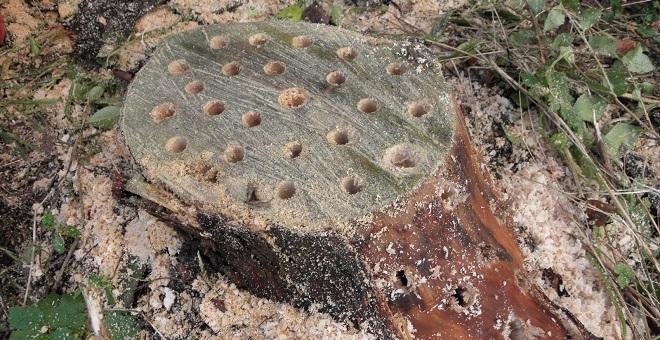
Old, exposed wood is less absorbent so for the best results its recommended to drill holes in the top of the stump at equal intervals to allow the chemical to penetrate the wood before applying. Once the chemicals have been applied inside the holes it will take some time to see the results, but it should begin to rot within a couple of weeks.
You may want to cover the stump with tarpaulin to lock in moisture which will encourage the fungal growth. Once the stump is soft enough you can remove it by chopping it with an axe and disposing of the waste appropriately.
Reasons to Remove a Tree Stump
There are many reasons that you may wish to remove a stump from your property, they include:
- Tree stumps can be unsightly features of a garden.
- They make garden maintenance more difficult.
- May be in the way of construction.
- If within close proximity to a building, the roots could cause issues with the structure.
- The tree may be diseased and failure to remove would allow the disease to spread.
DIY Tree Stump Removal
If you don’t want to pay a professional to remove a tree stump from your property it is possible to complete all the methods outlined above yourself, and you could almost certainly make a good saving on labour if you’re up to the physical work.
Physically removing the stump won’t cost much if you’ve already got a well-stocked arsenal of garden utensils, but if not, the tools recommended won’t cost an arm and a leg to invest in and could come in handy for future projects.
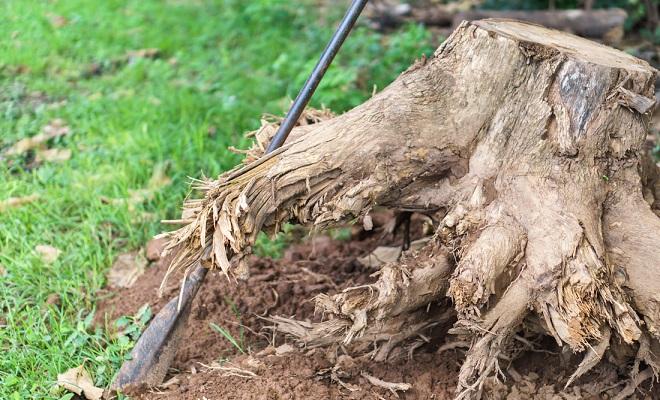
If you opt to absorb the stump grinding cost by doing it yourself, then the correct machinery can be rented from around £50-£100 a day. Although you should only do so if you are confident enough and if in any doubt, it may be best to hire a professional.
If you decide to burn a tree stump yourself you should keep in mind that kerosene is not a recommended accelerant as this hardens the wood and makes it much harder to remove, either by yourself or with professional help. Potassium nitrate costs roughly £8.50 a kilo and is a great oxidizer, meaning that it will help your fire maintain its heat whilst burning.
Similarly, it works well in the chemical method for tree stump removal and although it takes a long time to see results it does mean that the physical exertion needed in this method is minimised.
Cost to Remove a Tree
To remove a tree from your property, you can expect to hire a trained professional to complete the tree felling for roughly £250, assuming the tree is under 25 feet tall and only takes half a day to complete. For convenience, you can also request that the stump is removed at the same time, which will incur an additional cost, but does mean that all work is completed at the same time so you won’t have to revisit the project at a later date.
If it is safe to do so, you may wish to remove the whole tree yourself, though because of the potential hazards and dangers involved, it’s not recommended.
What to Consider Before Removing a Tree
Although having a tree on the property may not be desirable to you, it may be desirable to potential homebuyers in the future. Particularly if the tree is well-established, in good condition or is a fruit-bearing tree.
Weigh up not wanting the tree with the cost of its removal, and if removing it will mean you require additional gardening work or landscaping carried out in its place.
Sometimes you may find that tree felling is necessary, for example if a tree is likely to cause structural damage to your property or runs the risk of interfering with overhead powerlines. In these circumstances it is probably best to hire a professional service as they will be trained in the correct way to remove the tree without causing unnecessary damage and with minimal risk to the surrounding areas.
Another reason you may need to remove a tree is if there is evidence of trunk damage; trunk damage could result in the tree collapsing unexpectedly which could become very costly if repairs need to be made as a result so it’s best to act before it becomes an issue.
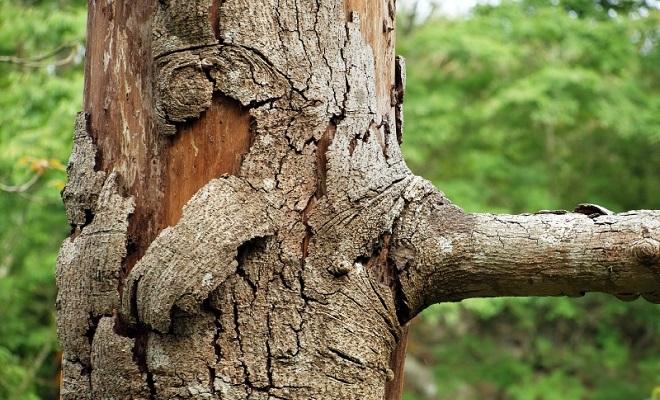
Similarly, if you notice signs of tree disease, it is best to act as soon as possible to treat it, but if the disease is too advanced, you may have to consider removing it to avoid the disease spreading to nearby plants. Treating a single case of tree disease will cost considerably less than having to decontaminate an entire garden.
Cleaning up After Removing a Tree Stump
Once the stump is gone you will have a choice of how to handle the resulting waste. Many arborists will be able to either give a removal cost or will include it in their initial price so it’s always best to check if this has been covered.
Alternatively, if you want to handle the waste clean-up yourself and save some money, you have several choices of how best to handle the waste: you may wish to remove the resulting debris yourself and take it to your local recycling centre, or repurpose large pieces for firewood if suitable.
You may also wish to keep the grindings and use them as mulch for your garden.
The Correct Way to Measure a Tree Stump
It’s important to ensure you measure your tree stump correctly to get an accurate quote; making sure that the correct measurement is given means that the service provider won’t quote for what they are expecting to be a small tree, but which in reality is much bigger.
Giving incorrect measurements may result in unexpected increased costs as they could affect labour time and what methods are used to complete the job.
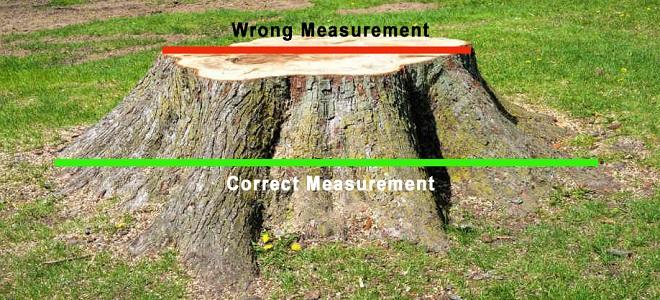
The given measurement of the stump should be its diameter from the base, and not from the top of the stump where the rest of the tree has been removed. Make sure to include any exposed roots in this measurement as they will also need to be removed and included in the work undertaken.
Factors That Impact Tree Stump Removal Costs
Tree stump removal can be a difficult task, with so many factors potentially adding to the cost of the job. If the tree was located in a precarious or difficult position, then this can influence the stump removal cost.
If it is more troublesome to gain access to the stump, for example bringing in machinery to the location, you will have to account for the extra time that this will take in completing the job.
Likewise, depending on the removal method chosen you may find that the job requires more labour. If you are planning on using the area to plant flowers or grass afterwards, you would need more of the stump removing than if you were going to lay slabs over the location. In this instance, it may be worth looking into the cost of a gardener to help landscape the area.
You will have to also consider if it is necessary to remove any roots that are attached to the stump or whether it is acceptable to leave them in the ground.
If the stump is located near underground pipes or cables, or in close proximity to a structure or property, this will also need to be taken into consideration. In these instances more planning and careful execution of the task will need to be taken, to ensure damage isn’t caused to the surrounding areas.
How to Save Money When Removing a Tree Stump
Explaining as much as possible about what's required for the tree stump removal can help lower costs when talking to a professional. The more details you are able to give a tradesperson the better, as this will help provide a clearer picture of the work required and they can adjust their costings accordingly.
Examples of such details include the size of the stump and soil type of the surrounding area (clay and other heavy soils will require more work manoeuvring and manipulating than lighter soils and so will be more labour intensive). The type of wood is imporant to note too as hardwoods (such as Oak) take considerably longer to grind than softer woods (such as Ash).
It's also possible to save in the costs of removing a tree stump by doing it yourself, but be aware that this can be both labour intensive and dangerous. As with any DIY project it’s important to ensure that appropriate safety precautions are taken and that machinery should only be operated by someone who is competent enough for the task.
For smaller stumps it is possible to dig it out yourself, along with its connecting root systems by using a mattock. Whereas for larger projects you may wish to look into the cost of hiring a stump grinder yourself, although rental grinders may not be as efficient as those used by professionals.
Planting a Tree
Once the stump has been eradicated you may want to think about planting a new one as a replacement. Planting it either near the site of the previous one, or if that’s not practical, elsewhere on your property, ensuring a gap of around 2 meters between trees to allow for growth.
There are numerous benefits of having trees, including:
- They help to prevent flooding and erosion by drawing moisture from the soil.
- They can increase property value.
- Encourage wildlife to the area as nesting spots or feeding grounds
- If planted strategically trees and hedges can also help reduce your energy costs as they help to block wind, potentially decreasing your heating costs in the colder months.
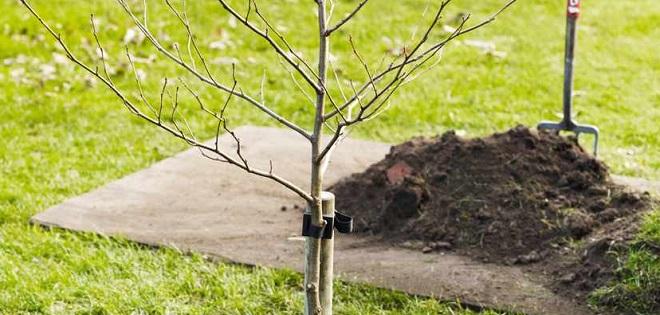
The cost of planting new trees can vary dependant on the species and size. A mature tree will cost considerably more than a sapling and your property may need additional preparation before it can be planted; your arborist will be able to advise you the best course of action to take, but an estimated cost of a single mature tree and its planting is between £200-£300.
Alternatively, you may wish to visit your local garden centre or nursery to purchase a smaller tree yourself, which could cost from as little as £7 from the right supplier.
Choosing the Right Professional
As with any job, it’s important to ensure you’ve got the right professional for the task at hand. Choosing the correct arborist for the job is vital because of the potential risks posed to the workmen, yourself and your property. Ask them if they are insured; and ask for any relevant evidence to support this.
You are within your rights to ask for references from your arborist, they should have a good record of past work. Do you know anyone that has had similar work done and how do they feel it was handled? Remember that you don’t have to commit to the first quote you are given.
A good arborist will be knowledgeable and be able to answer any questions you have; or may even ask you questions regarding the work. This is promising as it shows they are aware of different factors that need to be considered when giving a quote and when undertaking different projects.
You should expect them to ask about the size of the stump or stumps in question, their location within the property and whether there is adequate access to them.










